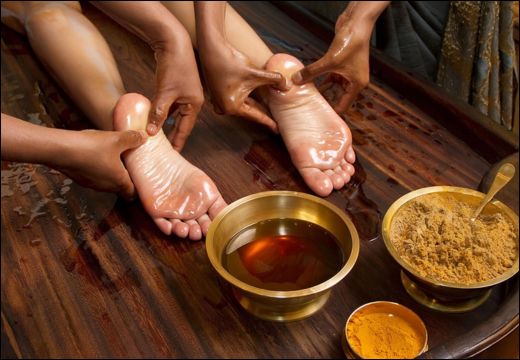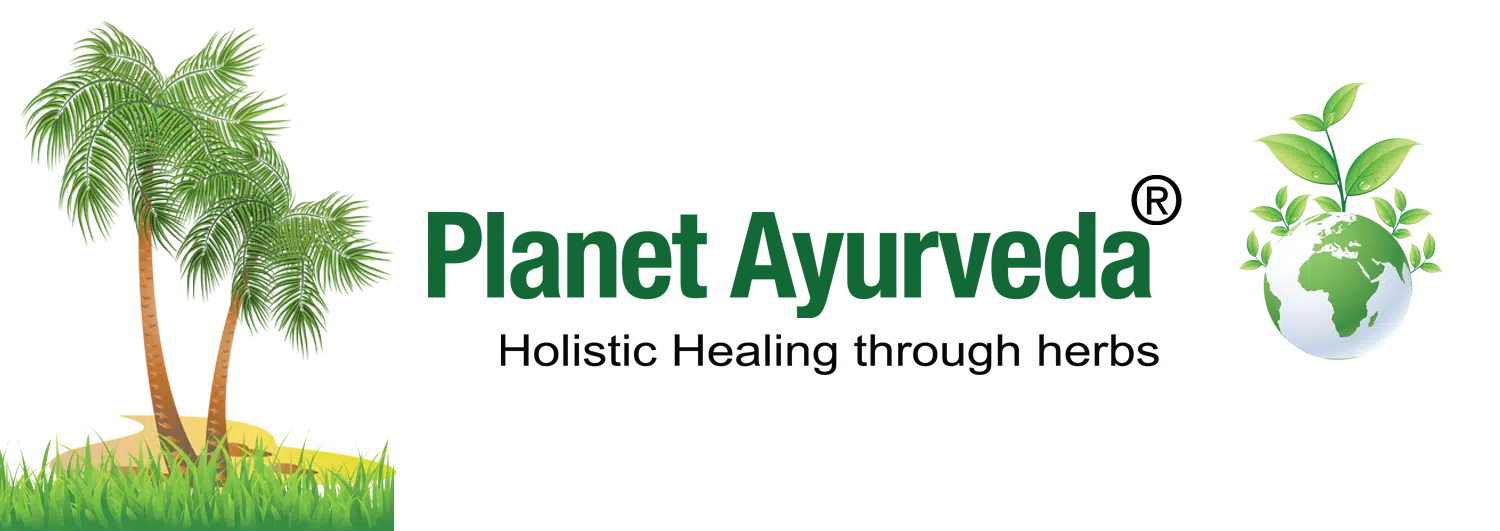Padabhyanga Massage in Ayurveda: Full Guide to Benefits & Method
Abstract
In Ayurveda, the feet are regarded as the foundation of the body and a reflection of its internal harmony. They serve as a bridge between the physical and subtle realms, carrying not only the body’s weight but also its vital energies. The soles of the feet are home to several Marma points and nerve endings that correspond to essential organs, channels (Srotas), and systems within the body. Just as roots nourish and stabilize a tree, the feet support and sustain the body’s strength, stability, and balance. When the feet are fatigued, neglected, or dry, the flow of Prana (life force) becomes disturbed, leading to discomfort, restlessness, and imbalance. Proper foot care thus becomes an act of both physical and spiritual nourishment, enhancing vitality, clarity, and emotional equilibrium. Among the numerous Ayurvedic practices designed for this purpose, Padabhayanga is one of the most cherished rituals, which we shall explore in detail in this article.

Introduction
Padabhayanga (Ayurvedic Feet Massage), is one of the most ancient and revered therapeutic rituals described in classical texts. The word Padabhayanga is derived from Pada (foot) and Abhyanga (oil massage), and it signifies the use of warm, medicated oils to nourish and relax the lower limbs. This ritual, performed daily or before sleep, holds deep physical, neurological, and energetic benefits. Ayurveda teaches that the feet are the seat of Vata dosha, the principle governing movement, nerve impulses, and sensory coordination. Unlike a mere relaxation therapy, it is a therapeutic act of balance and rejuvenation, harmonizing the physical and subtle layers of existence.
Ayurvedic Understanding And Classical Relevance
Ayurveda views the body as an integrated network of channels (Srotas) through which Prana and Rasa (nutritional essence) flow. The feet, being the terminal points of many of these channels, serve as vital gateways for restoring systemic harmony. The Marma points located on the soles, such as Talahridaya Marma and Kurcha Marma, are linked to major organs like the heart, liver, and brain. When these points are stimulated during massage, they regulate energy flow and awaken dormant vitality. In essence, Padabhayanga symbolizes the Ayurvedic principle of “healing from the base” — grounding the individual to stabilize the mind and strengthen the body’s root energy.
Procedure Of Padabhayanga
1. Get Ready
Sit or lie down in a quiet, warm place. Make sure you feel comfortable. Warm the oil a little — it should feel pleasant, not hot.
2. Apply The Oil
Put some oil on your palms and gently rub it on your feet — over the soles, toes, heels, and ankles.
3. Massage The Feet
Rub your feet slowly with your hands. Move your thumbs in small circles on the soles and heels. Massage each toe gently and press softly in the middle of the foot to relax the nerves and improve blood flow.
4. After The Massage
Do this for about 10 to 15 minutes on each foot. When done, wipe your feet with a warm towel or wash them with mild warm water. Then rest or go to sleep.
5. Best Time
The best time for Padabhayanga is at night before going to bed. It helps your body relax, calms your mind, and supports deep sleep.
Commonly Used Oils For Foot Massage
Ayurveda recommends the use of nourishing and stabilizing oils for daily Padabhyanga to maintain strength, suppleness, and vitality of the feet. The following oils are considered beneficial for overall foot health and nerve relaxation:
1. Tila Taila (Sesame Oil)
The most widely used oil in Ayurveda; warming, grounding, and deeply penetrating. It balances Vata dosha, strengthens tissues, and improves circulation.
2. Go Ghrita (Cow’s Ghee)
Cooling and rejuvenating; highly effective in conditions associated with aggravated Vata and Pitta, such as burning sensation, numbness, and diabetic neuropathy.
3. Ksheerabala Tailam
A gentle and nourishing medicated oil that soothes nerves, alleviates pain, and improves muscle tone.
4. Eranda Tailam (Castor Oil)
Warming and lubricating; eases stiffness, reduces swelling, and enhances flexibility of the joints.
Simplified Oil Selection Based On Dosha
For a simple Padabhyanga routine at home, easily available oils can be selected according to one’s Prakriti or doshic predominance:
1. When Vata Is Predominant
Use Sesame oil, Ghee, or Olive oil – warming, nourishing, and grounding.
2. When Pitta Is Predominant
Use Ghee, Coconut oil, or Sunflower oil – cooling and soothing to calm excess heat.
3. When Kapha Is Predominant
Use Ghee, Sesame oil, or Jojoba oil – light and mildly stimulating to prevent stagnation.
Additional Ayurvedic Insights
1. Tila Taila And Brahmi Taila
These are particularly beneficial for relaxation and promoting deep, restorative sleep. Brahmi Taila may also be applied over the scalp in Shiro-Abhyanga (head massage) alongside Padabhyanga to enhance mental calmness and improve sleep quality.
2. Sarshapa Taila (Mustard Oil)
This is excellent during cold seasons; it prevents dryness, stiffness, and fungal infections such as athlete’s foot.
3. Essential Oil Add-Ons
Adding a few drops of Rosemary or Lavender essential oil to base oils like Tila Taila enhances the relaxing effect, calms the mind, and relieves muscular tension after a long day.
Therapeutic Benefits Of Padabhayanga
1. Promotes Deep Sleep
Calms the nervous system and induces sound, restful sleep (Nidrajanaka effect).
2. Balances Vata Dosha
Reduces dryness, stiffness, and joint pain, particularly in legs and lower back.
3. Improves Vision
Classical texts mention improved eyesight as a direct benefit of regular foot massage.
4. Relieves Fatigue And Stress
By soothing Marma points, it releases tension and enhances circulation.
5. Improves Skin Texture
Nourishes cracked heels and dry skin, making them soft and supple.
6. Enhances Blood And Lymphatic Flow
Stimulates nerve endings and improves peripheral circulation.
7. Supports Nervous System Health
Strengthens neural coordination and stabilizes the mind.
8. Anti-Aging Effect
Regular practice prevents premature aging of feet and lower limbs.
Precautions And Contraindications
1. Avoid Right After Meals Or During Acute Illness
Avoid Padabhayanga immediately after meals or in acute fever, cold, or infection.
2. Avoid Cold Oils In Winter
Do not use cold oils in winter unless suitable for your Prakriti.
3. Avoid During Foot Infections
Avoid during fungal infections, ulcers, or open wounds on feet.
4. Kapha Dominance Precaution
People with Kapha dominance should use stimulating oils in moderate quantities to avoid lethargy.
Modern Relevance
In today’s lifestyle — dominated by long hours of standing, walking, or sitting — Padabhayanga is more relevant than ever. It eases digital-age fatigue, relieves foot pain, and supports emotional well-being. It serves as a form of neurological relaxation therapy, activating parasympathetic responses and improving sleep quality. This simple yet profound ritual bridges ancient wisdom and modern self-care, promoting grounding, calmness, and holistic rejuvenation.
Link to buy Herbal Oils, please visit store.planetayurveda.com/collections/herbal-oils
Conclusion
Padabhayanga is far more than a soothing foot massage — it is a profound Ayurvedic ritual that nurtures both body and mind. By stimulating Marma points and balancing Vata dosha, it restores vitality, promotes deep sleep, and enhances circulation. Regular practice strengthens the nervous system, relieves fatigue, and supports emotional calm. In the modern world, where stress and exhaustion are common, this simple daily ritual offers grounding, rejuvenation, and inner harmony. Embracing Padabhayanga reconnects us to the essence of self-care — healing, balance, and the flow of Prana throughout the body.



